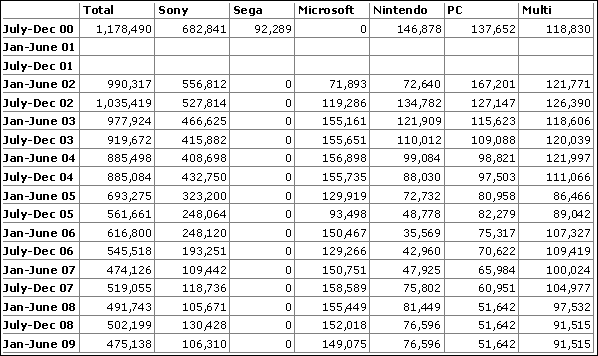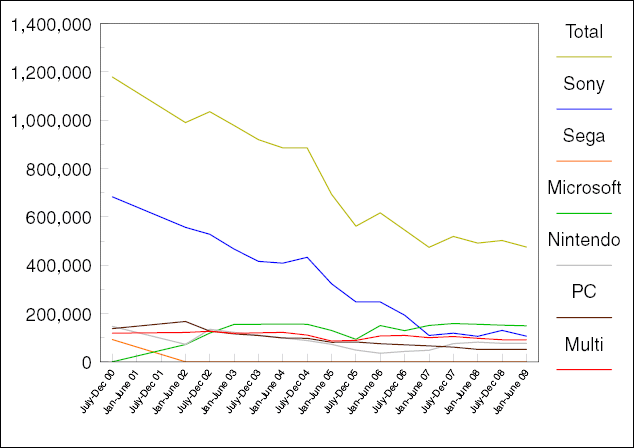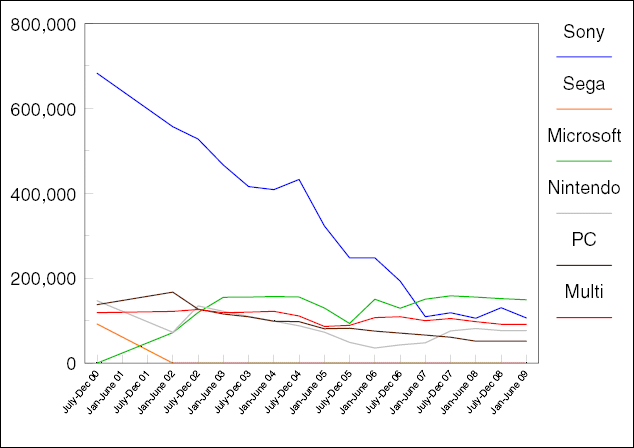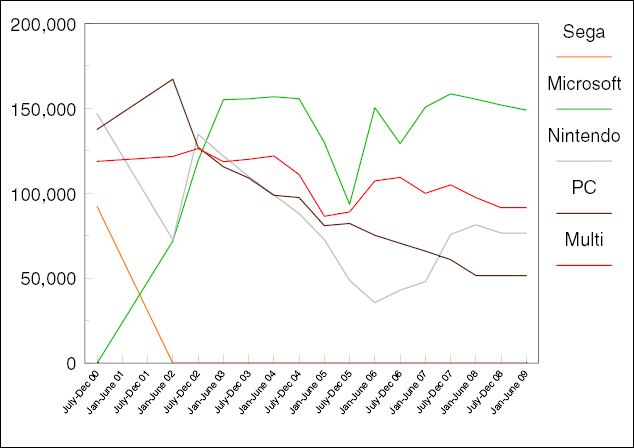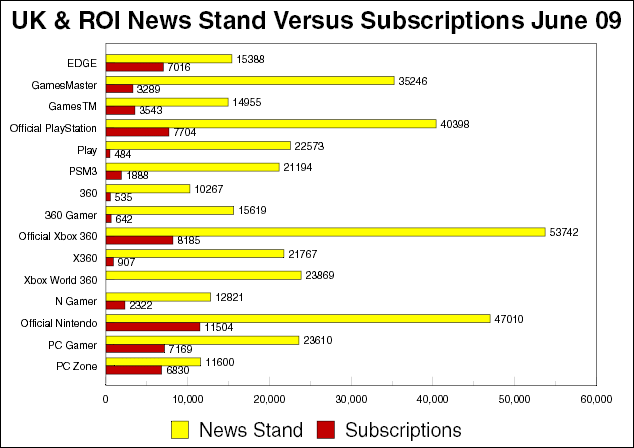Category:
Circulation
Here's my contribution to a "Is print dying?" debate that took place on the Gamespress.com forum following the news of Play*Gamer's launch.
==============================
Okay, let's clarify some things here.
Both print and online can work as businesses.
In both sectors you've got some doing well, and some doing badly.
There has been a lot of negative print news, so Macrike's original comment that it's interesting to see a new launch such as Play*Gamer amidst news of dwindling newspaper figures, still stands.
The data he linked to, was for the US market. I have little knowledge of the US Newspaper industry, but do know that in the US magazine market, subscriptions are far stronger. This is because the country is huge, and logistics are a nightmare. That means the newsstand is an advert for getting new readers, and once a reader has discovered a magazine, they are encouraged to subscribe.
The UK by contrast, has traditionally always been stronger at the newsstand, with subscriptions often an afterthought. However, the UK newsstand is currently suffering from a variety of issues, and so we should see publishers put more effort into subscription sales over the next few years.
Play*Gamer is from Uncooked Media, who have had a modest success with 360Gamer. They already have a multiformat games website, in the form of http://www.gamer.tm and it makes sense for them to complement their print 360Gamer with a PS3 equivalent now that the PS3 is at a cheaper price, and likely to perform well this Christmas.
In addition, Future have closed PSW. The pessimist in me believes this was to artificially instigate growth in circulation figures of OPM and PSM3 when the next ABC figures are published in Feb 2010, despite the recession and the decline of the videogames print sector.
Nonetheless, whilst this may mean PSW readers might move over to OPM and PSM3, it also means there is one less competitor for Play*Gamer to contend with.
The sad reality however, is that Play*Gamer isn't to my knowledge launching with much fanfare, and its 360 equivalent from Uncooked - 360Gamer - despite an attractive price and being 3-weekly, only recorded an ABC circulation of around 16k for the Jan-June period, and I would expect Play*Gamer to perform similarly.
This isn't an issue of print vs online, or even how good/popular Play*Gamer is.
Its circulation figures are more likely to be determined to a large extent by the distribution of the title. New magazines are profiled against existing competitors - if 360Gamer is doing 16,000, wholesalers Menzies and Smiths News will likely only take 30,000 copies into the 50,000 newsagents they supply (ergo, it won't be in all newsagents). To make matters worse, supply decisions are made according to where videogame magazines are already selling, meaning you cannot grow a title into new territories - you rather are stocked alongside competitors, which can further dilute the existing market rather than reach out to a new market. It also makes it difficult for one title to grow sales beyond what their segment of the market (i.e. the videogame mag category) is currently already achieving.
Another problem is retail promotions. These typically cost around £2000 per week, per chain. Speaking to Emma Parkinson (Publisher at Future) at the Golden JoySticks recently, she claimed they were effective only in that they gained you better listings at retailers, jokingly calling them a tax. These taxes can cripple new ventures.
Matt Martin, now working at Gamesindustry.biz, was once editor of Station Gamer, an A5 videogames magazine launched in 2003. "Station Gamer struggled with a few problems. One of which was the POS - it's expensive to have your mag supported with POS but essential for at least the first six issues while it's still new. You won't be able to get reliable sales figures back until at least issue 3/4 and by then you could have shelled out a lot of money. Shelf ends, FSDU's, talkies - whatever you want to call them - all cost a stack."
Station Gamer closed, having made a loss of £200,000; the A5 games mag concept hadn't worked.
Now, regarding advertising:
Adspend with Consumer Magazines in Q1 2009 was almost £178.5m [PPA Marketing referencing Nielson Media Research].
Magazines provide better audience engagement with advertising, and can deliver better value to planners than TV or Internet. [Simmons Multimedia Engagement Study, 2008 Full-year Study].
"..magazines are second only to videogames for consumers enjoying the content at the time they saw the ad". - MPA's Magazine Handbook 2009, p31, summarising data from The Futures Company Yankelovich MONITOR/Sequent Partners, 2008.
The total UK advertising market spend was £17.5bn in 2008, 19.5% of which was Print Display Advertising, behind TV advertising at 21%, and marginally infront of Internet advertising at 19.2%. An additional 13.1% of advertising spend was Print Classifieds Advertising. Source: PricewaterhouseCoopers / Internet Advertising Bureau / WARC.
In the first half of 2009, internet spend overtook both print and TV for the first time. However, the majority of growth was from paid-for search which showed an 11.8% year-on-year growth. Online classifieds and online display advertising [banners, etc] declined by 3.6% and 5.2% respectively, although given the recession, they still did well compared to other media, which according to the Internet Advertising Bureau (which is probably biased to promoting the internet), declined in double digits.
James Gale at Papercut Publishing mentioned Future are now block selling their advertising.
Whether he meant selling ads across multiple titles in one go, or booking ads for X number of issues, I'm really not sure.
Nonetheless, attending ABCe's Interaction 2009 at the beginning of this year, I noticed media companies were now talking about selling audiences to advertisers - the channel to reach them less important. In laymen terms - there was a trend towards packaging print and online advertising in one package.
A typical rate card for a 20k to 40k videogames magazine is currently £3000-£3500 for a full page spread.
A title such as Computer Active Magazine, which is managing an average of 177,000 copies a month can command £6384 for a full page spread.
This is similar to what Official PlayStation Magazine charged in 2001 - £7470 for a full page spread, when the magazine was selling 215,000 copies.
Yes, the videogames magazine sector has been in decline. I have figures dating back to 2000 that show this. I lack exact figures between 1997 and 1999, but it's well known there was explosive growth in 1998, when Essential PlayStation Magazine for example, shot up from 43,274 in 1997 to 173,412 in 1998. This was 3 years into the PSOne and two years before PS2. OPM shot up from 205k to 380k, and became the third best selling men's magazine in the country. Games mag sales have been in steady decline since this peak however. But it's interesting to note, despite an overall decline, PlayStation mag sales did briefly grow again four years into PS2.
Could it be that these moments, three or four years into a console's lifecycle, represent the point at which a console became mass market?
Between July and Dec 2000, on average 1.1million videogame magazines were sold a month in the UK. During this time, there were four dominant publishers - Dennis, Emap, Future, and Paragon.
Now there are two dominant publishers - Future and Imagine[Ex-Paragon/Highbury], and a handful of smaller publishers (Uncooked for example).
The number of dominant publishers, and the size of the market, has approximately halved.
Now 475,138 videogame magazines are bought on average each month. 370,059 of these are bought at the UK newsstand, generating in excess of £1.7m a month in revenue, or £21.5m per annum, in retail sales.
There is still money to be made from print. Speaking to Will Guyatt at the Golden Joysticks, he mentioned how being different was now key, citing Future's new World of Warcraft subscription only magazine, as an example of a new product, and new business model.
Emma Parkinson, Publisher at Future, also mentioned something similar to what JRWire has mentioned. "People don't stop having hobbies" she told me.
Nonetheless, online cannot be ignored. It's been so amazing to see Videogamer.com [once pro-g.co.uk], start out like any of the other fansites on these forums, and then be having 1.1million unique users, and giving its staff proper salaries. This couldn't have been possible without the growth in online ad revenue, in which, incidentally, the UK leads the way internationally (the UK is the world leader in terms of advertising market share for online, according to the IAB). And we've got GameSpot UK doing 4m, and Eurogamer 3.7m.
In short, I don't think anything is as black and white as some of the arguments in this thread imply.
In the last set of ABCs, Men's mags declined, whilst men's fitness and health mags increased for instance (i.e. it was a mixed bag of titles declining, and some growing). FHM are now bringing out their own health spin-off. Plus I'm still waiting to hear back on how the £2.50 Halloween/November issue promotion went for them. Publishers of the title, Bauer Media, also own 50% of 4Music, and so put free adverts for FHM on the channel, - they think across TV, Radio, Print and Online, and create synergies where necessary to further their business.
Also, with all the problems facing the newsstand, ShortList plumped for free distribution, bypassing the newsstand entirely, and has been rewarded with a 510,720k circulation. I believe it's the largest circulation men's magazine in the country, but admittedly am not currently looking at circulation figures of other men's mags, so can't be 100% sure.
The Metro meanwhile is doing 737,888 - and yes, it had a Nintendo Wii Fit Plus advert, as a wrap around cover last week - so where the specialist press don't cut it, other print titles do.
Nonetheless, there is reason for concern in print, and there are problems print mags need to solve to better compete with online.
Here are some choice quotes:
"Most magazine circulations will take a hit with dropping ABCs because publishers haven't been promoting enough. Meanwhile, newstrade wastage is rising, newstrade sales are dropping, publishers are putting prices up to compensate ....[this] constitutes a triple 'whammy'. Only a nutter, ignoramus or very unlucky person would fall into that kind of scenario" - Subscriptions expert Peter Hobday speaking out on the InPublishing forums, of the dilemma facing the news-stand.
"The Problem with print at the moment is that media groups were too quick to invest in magazine websites that weren't backed by proper business plans; too hasty to trim production costs on their core print products (you downgrade a consumer's favourite product and you expect them to pay even more while you give them less?); and have been too slow to realise that print products, in fact, need to be enhanced and reconfigured to compete with their digital siblings and same-sector competitors.
What's left is a rather lacklustre newsstand full of outstanding brands that now have all the production quality and innovation of a leaflet for a church bake sale." - Tyler Brûlé, Monocle.
"Everyone under the age of 20 has simply grown up without newspapers and magazines. We'll never get back to the volumes of the 1990s" - B2B Publisher, Publishing Futures 2009 survey.
"Generally any chat about the average gamer is a bit nuts – it's a mass market pursuit now with the associated niches and segments – you can't sell anything to gamers en-masse, you have to pitch it at the appropriate niche," - Sean Droomgoole, Some Research / GameVision European Intelligent Report (speaking to MCV in August 2008).
Personally, I think it's like Radio wondering what to do when TV launched. But despite TV's dominance, Radio is still with us, and we still appreciate it in certain circumstances - such as when we're in the car.
I'll finish with some graphs and tables you may find interesting:
